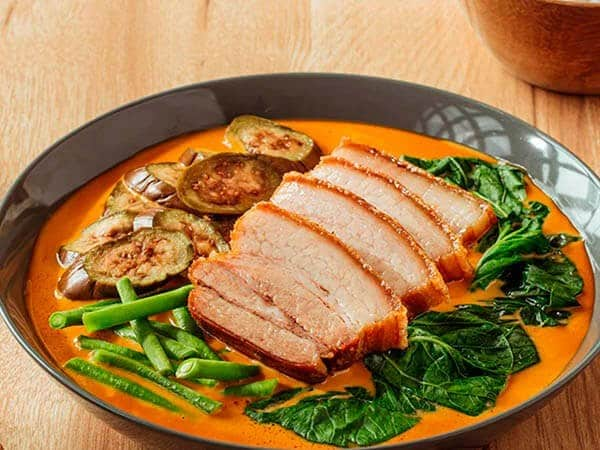Learn the Art of Traditional Filipino Food Recipes.
Authentic Filipino Food Recipes to Attempt in the house
Discovering genuine Filipino food dishes offers a possibility to value the detailed flavors and social value behind each dish. Making use of fresh, local components is crucial, as is welcoming common dining-- a trademark of Filipino society.
Popular Filipino Dishes
Filipino food flaunts a rich tapestry of tastes and practices, with over a lots iconic recipes that highlight the nation's diverse social impacts. One of the most well-known meals is Adobo, a mouthwatering stew commonly made with poultry or pork, seasoned in vinegar, soy sauce, garlic, and flavors. Its appetizing taste profile makes it a staple in Filipino households.
An additional cherished dish is Sinigang, a sour soup often made with tamarind, tomatoes, and numerous veggies. This meal can feature pork, shrimp, or fish, and its revitalizing preference is best for cozy climates. For those with a wonderful tooth, Leche Flan-- a velvety sugar custard-- functions as a popular dessert, showcasing the Filipino propensity for abundant, sweet tastes.
Kare-Kare, a hearty oxtail stew with a thick peanut sauce, along with the legendary lumpia, or springtime rolls, further exemplify the selection located in Filipino cuisine. Each recipe not only supplies unique tastes yet also informs a tale of regional active ingredients and historical influences, making Filipino food a vivid reflection of its culture and heritage.
Essential Active Ingredients for Filipino Cooking
The essence of Filipino cooking hinges on its vital ingredients, which work as the structure for the country's precious meals. A range of tastes and textures collaborated, showcasing the varied social influences that shape Filipino cuisine.
Secret ingredients include rice, the staple that goes along with virtually every meal, representing nourishment and area. Soy sauce, vinegar, and fish sauce (patis) are essential for spices, imparting umami and deepness to recipes. Fresh natural herbs like cilantro and basil include fragrant freshness, while garlic, onion, and ginger offer a durable taste base.
Protein resources such as pork, poultry, and seafood are main to several dishes, frequently marinaded to enhance preference. Vegetables like eggplant, bitter melon, and eco-friendly beans add crucial nutrients and equilibrium - Filipino food recipes. Coconut milk is an additional significant active ingredient, lending creaminess and a refined sweet taste to numerous stews and treats
Finally, calamansi, a citrus fruit, uses a rejuvenating flavor that elevates recipes and drinks alike. With each other, these active ingredients develop the dynamic and abundant tapestry of flavors that define Filipino cuisine, making it both comforting and distinctive. Understanding these principles is vital for any individual aiming to reproduce genuine Filipino dishes in the house.
Step-by-Step Recipe Overview

Begin by preparing your ingredients. For Adobo, slice the meat into consistent pieces and marinate it in soy sauce, vinegar, garlic, and bay leaves for at the very least 30 minutes. Next off, important source warm oil in a frying pan and sauté the garlic and onions till great smelling, after that add the marinated meat, permitting it to brownish evenly.
For Sinigang, begin by steaming water in a pot and including your choice of meat. As soon as tender, integrate tamarind paste or fresh tamarind for that resource trademark sour flavor. Adhere to with vegetables like radish and kangkong, food preparation until just tender.

Tips for Genuine Flavor
Frequently, accomplishing authentic flavor in Filipino meals hinges on the mindful selection and therapy of ingredients. Begin with fresh, high-grade produce, as the vibrancy of vegetables and herbs significantly boosts the dish's general taste. Staples like garlic, onions, and ginger create the fragrant structure for several dishes; utilizing them in proper proportions is critical.
Picking the ideal healthy protein is similarly important. For instance, standard adobo frequently employs hen or pork, marinaded to absorb the sauce's full taste. Additionally, take into consideration sourcing in your area produced or local active ingredients, as they can provide authenticity that store-bought options lack.
Food preparation strategies also play an important function. Slow-cooking methods, such as braising or stewing, enable flavors to fuse wonderfully, while frying can include a satisfying appearance. Don't forget spices; using salt, fish sauce, or soy sauce at the appropriate minutes can elevate a meal dramatically.
Serving and Appreciating Filipino Food
Culinary experiences are enhanced when Filipino food is served with interest to custom and neighborhood. The technique of sharing dishes is central to Filipino society, representing unity and hospitality. When serving Filipino meals, think about using typical serveware, such as clay pots or bamboo baskets, which enhance the credibility of the experience.
Normally, Filipino dishes are appreciated family-style, with a range of recipes positioned at the center of the table. read more This common method urges interaction and enables visitors to sample various flavors. A well-curated spread could consist of staples like adobo, sinigang, and lumpia, enhanced by rice, which is a fundamental part of every meal.
Coming with the food with traditional condiments, such as soy sauce, vinegar, or chili paste, can elevate the dining experience, inviting restaurants to tailor their plates to their choices. In addition, including neighborhood drinks, like calamansi juice or tuba, can boost the general taste profile.
Verdict
:max_bytes(150000):strip_icc()/Filipino-Features-Hero-Final-2-b785e627967843b0aa631c6a977adabe.jpg)